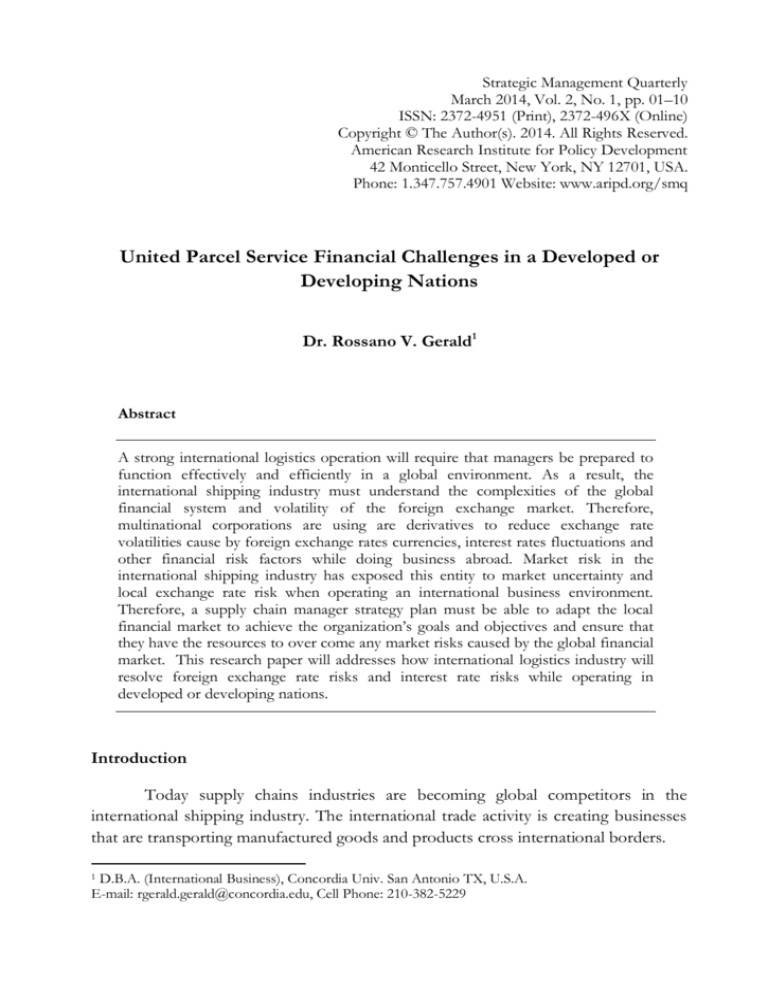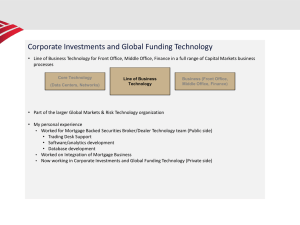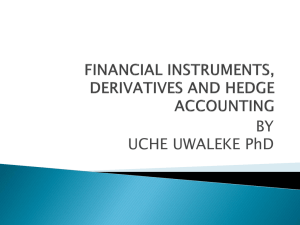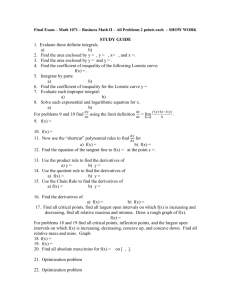
Strategic Management Quarterly
March 2014, Vol. 2, No. 1, pp. 01–10
ISSN: 2372-4951 (Print), 2372-496X (Online)
Copyright © The Author(s). 2014. All Rights Reserved.
American Research Institute for Policy Development
42 Monticello Street, New York, NY 12701, USA.
Phone: 1.347.757.4901 Website: www.aripd.org/smq
United Parcel Service Financial Challenges in a Developed or
Developing Nations
Dr. Rossano V. Gerald1
Abstract
A strong international logistics operation will require that managers be prepared to
function effectively and efficiently in a global environment. As a result, the
international shipping industry must understand the complexities of the global
financial system and volatility of the foreign exchange market. Therefore,
multinational corporations are using are derivatives to reduce exchange rate
volatilities cause by foreign exchange rates currencies, interest rates fluctuations and
other financial risk factors while doing business abroad. Market risk in the
international shipping industry has exposed this entity to market uncertainty and
local exchange rate risk when operating an international business environment.
Therefore, a supply chain manager strategy plan must be able to adapt the local
financial market to achieve the organization’s goals and objectives and ensure that
they have the resources to over come any market risks caused by the global financial
market. This research paper will addresses how international logistics industry will
resolve foreign exchange rate risks and interest rate risks while operating in
developed or developing nations.
Introduction
Today supply chains industries are becoming global competitors in the
international shipping industry. The international trade activity is creating businesses
that are transporting manufactured goods and products cross international borders.
1
D.B.A. (International Business), Concordia Univ. San Antonio TX, U.S.A.
E-mail: rgerald.gerald@concordia.edu, Cell Phone: 210-382-5229
26
Strategic Management Quarterly, Vol. 2(1), March 2014
Supply chain managers are implementing international logistics operation
systems that can adjust to a volatile foreign currency and interest rates that provide
revenue and profit for their global distribution systems. For instance, United Parcel
Service is a multinational corporation that is based on integrated logistics network
system, in which package products are been delivered to a global market. By
implementing a unique financial strategy, it enabling them to improve service,
introduced new products, and expand their market. However, “the international
shipping industry has certain characteristics, which make it particularly vulnerable to
exchange rate risk.” (Akatuska & Leggate, 2001, p.235)
For instance, United Parcel Service (UPS) is exposed to certain market risks
from changes in the foreign exchange market. These foreign risks in the international
logistics business are related to its transportation structure, revenue, operating costs
and financing transactions in currency other than their local currencies while
operating aboard. Effective global supply chain management system depends on
favorable currency fluctuation within the foreign exchange rates. Exchange rates are
volatile financial instruments that rarely move in the same directions. As a result,
multinational corporations’ assets and liabilities denominations of foreign currencies
are impacted by fluctuating exchange rates. Therefore, exchange rate fluctuations
between foreign currencies and the US dollar can impact the performance of the
international logistics industry in terms of operating costs and profit gains. “Market
risk generated by price volatility of underlying financial assets is a major source of
exposure for derivatives participants. Since many derivatives are highly leveraged, a
small change in interest rates, equity prices, or exchange rates may cause major
changes in interest rates, equity prices, or exchange rates may cause major changes in
the values of derivatives products.” (McClintock, 1996, p.24)
As a result, UPS is exposed to market risk from changes in foreign currency
exchange rates and interest rates. This market risks comes from conducting business
in a global environment. According to UPSs’ finance department, its has integrated
global business model that evaluates the financial market risks primarily due to
changes in the exchange rates and interest rates markets. This organization is using
various financial instruments such as forward contract, options and swaps to levitate
market risk in a global economy. This paper will analyses UPS’s Annual Report (2004)
to address how this organization can reduce foreign exchange rates and interest rates
risks by using derivatives instruments that allows it to hedge against market volatility.
Rossano V. Gerald
27
Review of the Literature
Foreign Exchange Rates Risk
United Parcel Service is exposed to currency risk from the potential changes
in functional currency values of its foreign currency-denominated assets, liabilities,
and cash flows. This foreign exchange exposure is related to currencies such as the
Euro, the British Pound Sterling and the Canadian Dollar. By using a combination of
purchased and written options and forward contracts to hedge cash flow currency
exposures. These derivative instruments generally cover forecasted foreign currency
exposures for period up to one year. “Derivatives possess a range of characteristics
that make them desirable as assets. These instrument values are linked to the value of
other assets without the holder of the derivative having to take a fully paid up position
in the other assets.” (McClintock, 1996, p.17)
This financial contracts is assets based on the value of commodities, foreign
exchange, bonds and stocks. By taking the form of futures, options, swaps and
interest. It present value is equal to the future exchange rates within that market.
Therefore, its value will change occurring to the market valuations and the contract
agreement during that time period. Thus, the link between derivatives and exchange
rate seems to be an important hedging instrument that explains association between
translation and transaction exposures.
Transaction vs. Translation Hedging Strategy
Which foreign exchange exposure is best suited for this international logistics
entity? According to Hagelin and Pramborg (2004), “Transaction exposure to
currency risk refers to potential changes in the value of future cash flows as a result of
unexpected changes in exchange rates. If competently executed, transaction exposure
hedges should reduce the variability of cash flows and consequently the variability of
firm value. Translation exposure, on the other hand, arises as the financial accounting
statements of foreign affiliates are translated into currency of the parent firm.” ( p.3).
For example, UPS’s financial management department is translating the results of
operations of their subsidiaries using average exchange rates during each period,
whereas balance sheet accounts are translated using exchange rates at the end of each
period.
28
Strategic Management Quarterly, Vol. 2(1), March 2014
Balance sheet currency translation adjustments are recorded in other
comprehensive income (OCI). Net currency transaction gains and losses included in
other operating expenses were pre-tax gains of $44 million in 2004. Therefore, the
company policy is to use derivatives financial instruments only to the extent necessary
to manage exposures. While using price sensitive instruments to hedge a certain
portion of their existing and anticipated transactions; any loss in value for those
instruments generally would be offset by increase in the value of those hedging
transactions. As a result, foreign exchange exposure is reduced when hedging
translation exposure and transaction exposures are used as financial instruments. In
other words, “a successful hedging program may increase shareholder value by
reducing costs related to different market imperfections.” (Hagelin and Pramborg,
2004, p.15)
However, developed and developing nations might require different hedging
programs to reduce foreign exchange rates risks in those regions. UPS’s financial
analysts found that currency derivatives markets are not readily available in developing
nations. For example, Latin America and Asia Pacific nations are starting to use
derivatives as hedging instruments in way to reduce foreign exchange exposure and
increase indirect foreign investment for their economic markets. Therefore, crosshedging should be used, because it expands the opportunity set of hedging
alternatives. As a result, multinational firms exposed to currencies of these countries
are able to reduce their foreign exchange risk exposure and at the same time attract
foreign investors. (Chang & Wong, 2003). Since derivatives instruments could be used
to forecast foreign currency exposures in a global financial environment. Then UPS
must use different options and swaps contracts to hedge cash flow currency
exposures and reduce market risk.
The Management of Derivatives Instruments
How derivatives are been use to reduce risks caused by foreign currency
exchange and interest rates? “Since many derivatives involve cross-border trading,
the derivatives market has led to increased international financial fragility and the
attendant need for greater supranational governance of derivatives.” (McClintock,
1996, p.13). As a result, UPS doe not engage in speculative trading activities; the
company use valuation models to evaluate the sensitivity of the fair value of financial
instruments with exposure to market risk that assume instantaneous, parallel shifts in
exchange rates and interest rate yield curves.
Rossano V. Gerald
29
For example, derivatives that not designated as hedges must be adjusted to
fair value through income. If a derivative is designated as a hedge, depending on the
nature of the hedge, changes in its fair value that are considered to be effective, as
defined, either offset the change in fair value of the hedge assets, liabilities, or firm
commitments through income, or are recorded in OCI until the hedge item is
recorded in income. Any portion of a change in a derivative’s fair value that is
considered to be ineffective, or is excluded from the measurement of effectiveness, is
recorded immediately in income. Therefore, UPS is using financial hedging to reduce
risk associated with currency derivatives and or/ foreign denominated debt.
According to McClintock (1996), derivatives instruments take the form of
futures, options, and interest and currency swaps. They are contractual agreements for
future exchange of assets whose present value are equal; however, the value of the
derivatives will change over the term of the contract as market valuations the value of
each side of the contract.” (p.15). To manage the market volatility pertaining to these
contractual agreements; UPS has implemented policy and practice that allow them to
manage fluctuations in earning and cash flows associated with changes of assets and
liabilities exposure caused by using these derivatives. In doing so, UPS can take
advantage of those financial instruments such as forward contracts and swaps. Thus,
how these derivatives are used in the local market determine the success of the
contractual agreement. According to UPS’s financial department, they are using
forward contracts, swaps and options to minimize credit market risk exposures for
these instruments by limiting the counterparties to large banks and financial
institutions to their established credit guidelines. This is main reason why; “bank and
non-financial corporations have sought to transfer interest rate risk by arbitrage
activities using derivatives either to take advantage of difference in the cost of capital
between credit markets or gain from temporary divergences in prices between
derivatives and their underlying assets. Banks generate fee income from derivatives
trade and take uncovered positions to speculate in the hope of attaining capital gains.
(McClintock, 1996, p.18)
Interest Rate Risks
As a result, UPS are using interest rate swaps and cross-currency interest rate
swaps, as financial instrument in order to manage the fixed and floating interest rate
mix of their total debt and leverage cost.
30
Strategic Management Quarterly, Vol. 2(1), March 2014
Because swaps requires small amount of principal, this allows them to
maintain a target ranges of floating rate debts. In return, UPS can swap their fixed
interest rate loan for floating rate loan of a counterparty resulting in an interest rate
swap. According to UPS’s financial managers, the company floating rate debt and
interest rate swaps risks are due to changes in short-term (i.e. LIBOR) market. “There
is some market risks related to the interest rate used on the hedge for the floating leg
of the swap. Typically the floating rate is a publicly available benchmark rate such as
LIBOR, which is determined as the average of LIBOR posted on a publicly available
financial news service by a number of reference banks. The identity of the banks
providing the LIBOR used to compute the average is determined by industry
convention, and can change from time to time.” (Klein, 2004, p.49). Therefore, UPS’s
annual interest expense changes are resulting form a hypothetical 100 basis point
change in short-term interest rates applied to their floating rate debt and swap
instruments of $29 million for this period.
Option, Forward contracts and Swaps Risks
As far as cross-currency swaps, the organization could swap a loan
denominated in U.S. dollar for a loan denominated in British Pound Sterling to reduce
interest rates and foreign exchange risk during term of their contractual agreement.
For example, the organization’s foreign currency exposure is due to the Euro, the
British Pound Sterling, and Canadian Dollar. They use a combination of purchase and
written options and forward contract to hedge currency cash flow exposure. These
contract accounts are cash flow hedges that anticipate foreign currency denominated
revenue in which gains and losses from these hedges are accounted on the
international revenue statement for this period. “This assumption is relatively sound
for short-dated forward contract, because the market maker is unable to hedge at riskless or repo rates longer-dated maturities. This point is particularly important because
most swaps have relatively long terms to maturity of between two and five years.” (In,
Brown & Fang, 2003, p.85)
As a result, options positions strategy is used as hedging tool were the
underlying asset market is based on these derivative instruments. This dynamic
hedging strategy is creating linkage between derivatives and underlying asset prices,
which might change its initial price, because of its adjustment towards the written
options positions. (McClintock, 1996). Therefore, UPS is maintaining their crosscurrency interest rates swaps through 2009.
Rossano V. Gerald
31
These derivatives instruments are allowing the organizations to account for
those contracts as either hedges of the fair value of the associated debt instruments,
or as hedges of the variability in expected future interest payments. Also, “It is also
important to recognize that when it hedges a swap, the market maker is
simultaneously hedging a series of fixed-and-floating-rate exchange that occur over
the life of the swap.” (Klein, 2004, p.49)
International Package Operation Revenue
These derivatives financial instruments are benefiting the UPS’s international
segment by increasing export volume to 12.5 percent from 8.5 percent, operating
profit each all time high of $1 billion, and operating margins increased to 16.6 percent
from 10.5 percent, which is leading all other international package industries. For
example, the organization’s international package revenue has increased 21.6% from
last year report of 12.5% due to the currency fluctuations. This increase in operating
profit was due export volume that grew by double-digit due to Asia-Pacific, China and
the European Union countries. As a result, the international package revenue increase
by $231 million due to better forecasted foreign currency exposures for this time
period. According to UPS’s financial department, its international average daily
package volume increase 7 percent and export revenue per piece increase by 9.0
percent for this period due to (3% and 6% currency adjustment) their geographical
markets. There are market risks involved for exporting firms and currency inventory
practices that might cause appreciation or depreciation of export revenues, if there is
an increase exchange risk, and then the net effect could be negative. UPS’s Financialdecision makers might be advised to remember exchange risk when considering
market intervention to stimulate export revenues. (Fang & Thompson, 2004).
Hence, UPS’s international financial strategy is influenced by the foreign
exchange currency risk and interest rates risk of other countries such as Asia-Pacific,
China, Canada, and European Union. These countries international monetary policies
are influencing UPS’s global small package delivery business for those geographical
regions. As a result, UPS’s international financial tactics are benefiting their
international small package operation by increasing its revenue up to 12 percent,
profitability up 58 percent, and volume up 7 percent in these underlying regions such
as Europe, Asia and China. This plan should help UPS when seeking new growth
opportunities in this global business environment.
32
Strategic Management Quarterly, Vol. 2(1), March 2014
Also, UPS’s financial position will enable them to reinvest capital into their
business, thus reduce finance cost, and offset anticipate cash inflow due to exposure
from currency exchange rate and interest rate risks.
Summary
This study revealed that UPS’s Annual Report (2004) is providing information
on their domestic, international and supply chain operations. These financial factors
are crucial in the assessment of the company’s international operation in how they are
using financial instruments to reduce finance cost and increase shareholder wealth. As
a market participants in the foreign exchange market (i.e. institutional investors or
non-financial corporations), they are using derivatives instruments to reduce foreign
exchange exposure and transferring interest rate risk by arbitrage activities that gives
them an advantage of using the cost of capital between credit markets or gain from
temporary divergences in prices between derivatives and their underlying assets.
(McClintock, 1996). Thus, UPS’s financial strategy is providing consistency in revenue
and earning growth for this corporation and their subsidiaries.
Future research recommendation Future research needs to be conducted on
how UPS’s financial strategy is influence when the systemic risk factors are causing
financial shocks in their international business environments. “Systemic risk refers to
the vulnerability of the financial system to shock. Risk faced by individual firms may
be magnified into systemic risk, the larger the firm is in relation to the size of the
market and the more integrated its market relationships with other major participants.
Financial markets under capitalism are periodically subject to shocks that generate the
possibility of systemic failure. At the close of the century, because of the high
proportion of cross-border derivatives transactions, systemic risk takes on a more
international character. (McClintock, 1996, p.26)
What kind international financial strategy could be implemented by UPS to
reduce systemic risk in a volatile foreign exchange market? It would be interesting to
examine what geographical financial markets are designed to prevent systemic failure
due to increase derivatives trading and lack of transparency associated with swaps
among developed or developing nations. Because these financial factors are important
in determining how international market pricing volatilities and derivatives
instruments are influencing the UPS’s underlying assets while operating in this global
financial market.
Rossano V. Gerald
33
References
Akatuska, K., & Leggate, H. K. (2001). Perceptions of foreign exchange rate risk in the
shipping industry. Maritime Policy & Management, 28(3), 235-249.
Barton, J. (2001). Does the use of Financial Derivatives affect earnings management
decision?. The Accounting Review, 76(1), 1-26.
Brooks, R., Edison, H., Kumar, M. S., & Slok, T. (2004). Exchange rates and Capital Flows.
European Financial Management, 10(3), 511-533.
Chang, E. C., & Wong, K. P. (2003). Cross-hedging with currency options and futures.
Journal of Financial and Quantitative Analysis, 38(3), 555-568.
Collin-Dufresne, P., & Solnik, B. (2001). On the Term Structure of Default Premia in the
Swap and LIBOR. The Journal of Finance, LVI(3), 1095-1114.
De Vita, G., & Abbott, A. (2004). The impact of exchange rate volatility on UK exports to
EU countries. Scottish Journal of Political Economy, 51(1), .
Fang, W. S., & Thompson, H. (2004). Exchange rate risk and export revenue in Taiwan.
Pacific Economic Review, 9(2), 117-129.
Hagelin, N., & Pramborg, B. (2004). Hedging foreign exchange exposure: risk reduction from
transaction and translation hedging. Journal of International Financial Management
and Accounting, 15:1, 1-19.
Hatemi-j, A., & Irandoust, M. (2000). Exchange rates and interest rates: can their causality
explain international capital mobility?. International Trade Journal, XIV(3), 299-313.
In, F., Brown, R., & Fang, V. (2003). Links among interest rate swaps markets: U.S., U.K.,
and Japan. The Journal of Fixed Income, , .
Klein, P. (2004). Interest rate swaps: Reconciliation of models. The Journal of Derivatives, ,
46-59.
McClintock, B. (1996). International financial instability and financial derivatives market.
Journal of Economic Issues, , 14-33.
Peterson, S., Stapleton, R. C., & Subrahmanyam, M. G. (2003). A Multifactor Spot Rate
Model for the pricing of Interest Rate Derivatives. Journal of Financial and
Quantitative Analysis, 38(4), 847-900.
Rutkowski, M. (1999). Model of Libor and swaps. Applied Mathematical Finance, 6, 29-60.
United Parcel Service (2004, December 31). UPS Annual Report 2004. Retrieved December
9, 2004, from www.ups.com and interviews were conducted with the finance
department personnel








